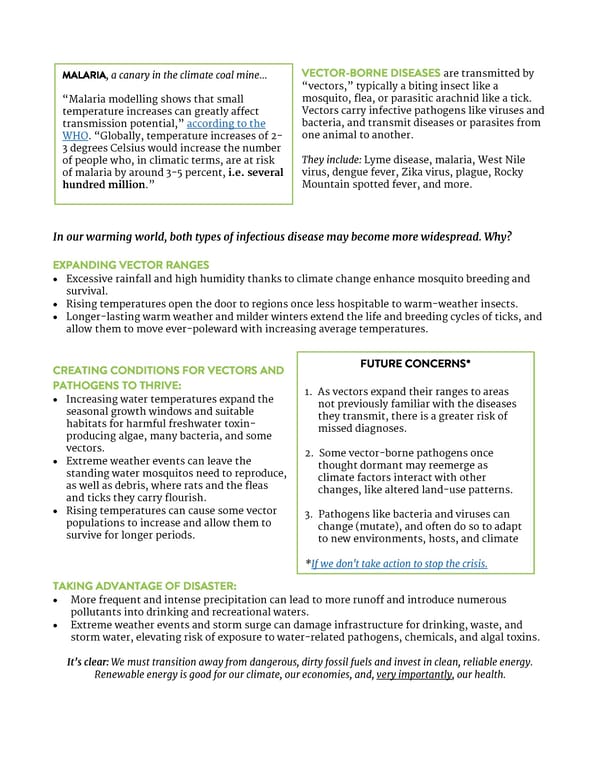MALARIA, a canary in the climate coal mine… VECTOR-BORNE DISEASES are transmitted by “vectors,” typically a biting insect like a “Malaria modelling shows that small mosquito , flea , or parasitic arachnid like a tick . temperature increases can greatly affect V ectors carry infe ctive pathogens like viruses and transmission potential,” according to the bacteria, and transmit disease s or parasite s from WHO . “Globally, temperature increases of 2 - one animal to another. 3 degrees Celsius woul d increase the number of people who, in climatic terms, are at risk They include: Lyme disease, malaria, West Nile of malaria by around 3 - 5 percent, i.e. several virus, dengue fever, Zika virus, plague, Rocky hundred million .” M ountain spotted fever, and more. In our warming world, both types of infectious disease may become more widespread . Why? EXPANDING VECTOR RANGES • E xcessive rainfall and high humidity thanks to climate change enhance mosquito breeding and survival. • Rising temperatures open the door to regions once less hospitable to warm - weather insects. • Longer - lasting warm weather and mild er winters extend the life and breeding cycles of ticks, and allow them to move ever - poleward with increasing average temperatures. FUTURE CONCERNS* CREATING CONDITIONS FOR VECTORS AND PATHOGENS TO THRIVE: 1. As vectors expand their ranges to areas • Increasing water temperatures ex pand the not previously familiar with the diseases seasonal growth windows and suitable they transmit, there is a greater risk of habitats for harmful freshwater toxin - missed diagnoses . producing algae , many bacteria , and some vectors . 2. Some vector - borne pathogens once • Extreme weather events can leave the thought dormant may reemerge as standing water mosquitos need to reproduce , climate factors interact with other as well as debris , where rats and the fleas changes, like altered land - use patterns. and ticks they carry flourish . • Rising temperatures can cause some vector 3. Pathogens like bacteria and viruses can populations to increase and allow them to change (mutate), and often do so to adapt survive for longer periods. to new environments, hosts, and climate * If we don't take action to stop the crisis. TAKING ADVANTAGE OF DISASTER: • More frequent and intense precipitation can lead to more runoff and introduce numerous pollutants into drinking and recreational waters. • Extreme weather events and storm surge can damage infrastructure for drinking, waste, and storm water, elevating risk of exposure to water - related pathogens, chemicals, and algal toxins. It’s clear: We must transition away from dangerous, dirty fossil fuels and invest in clean, reliable energy. Renewable energy is good for our climate, our economies, and, very importantly , our health.
 Fossil Fuels and Health: Infectious Disease Page 1
Fossil Fuels and Health: Infectious Disease Page 1 